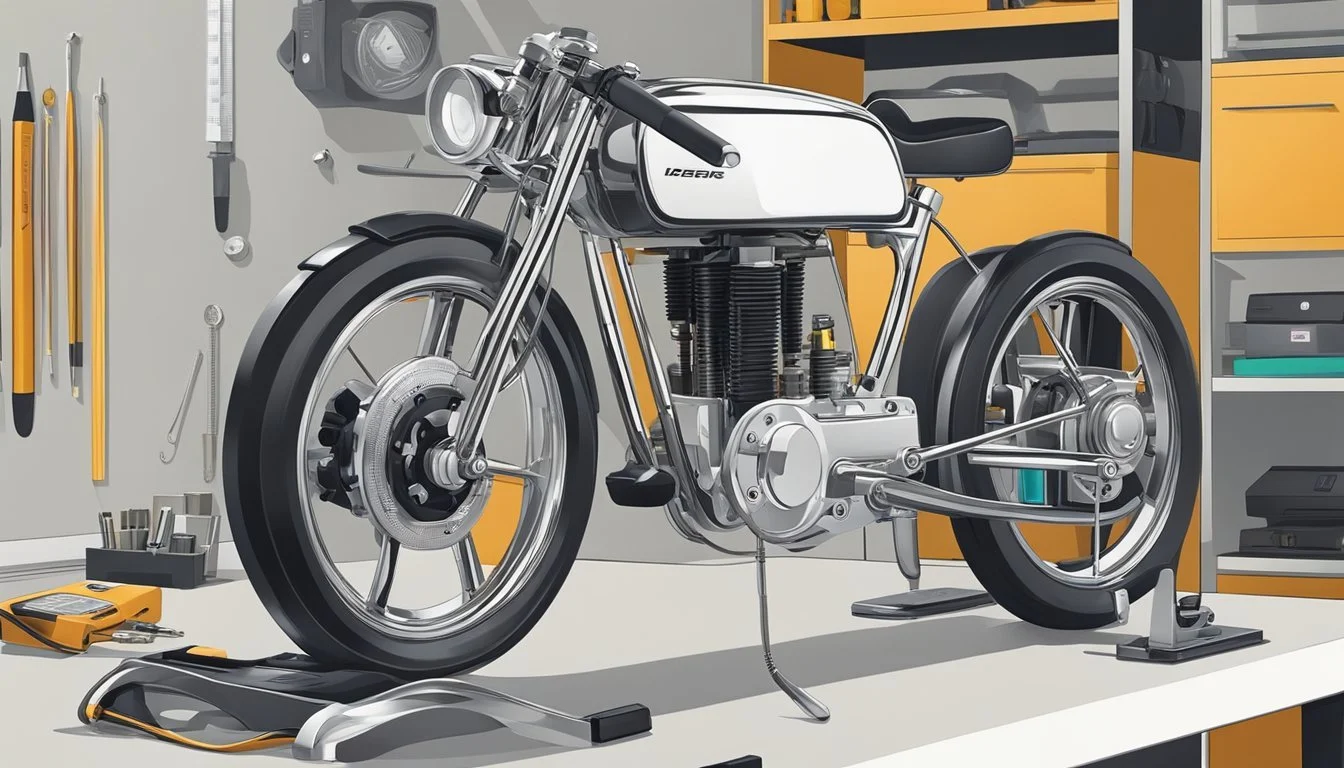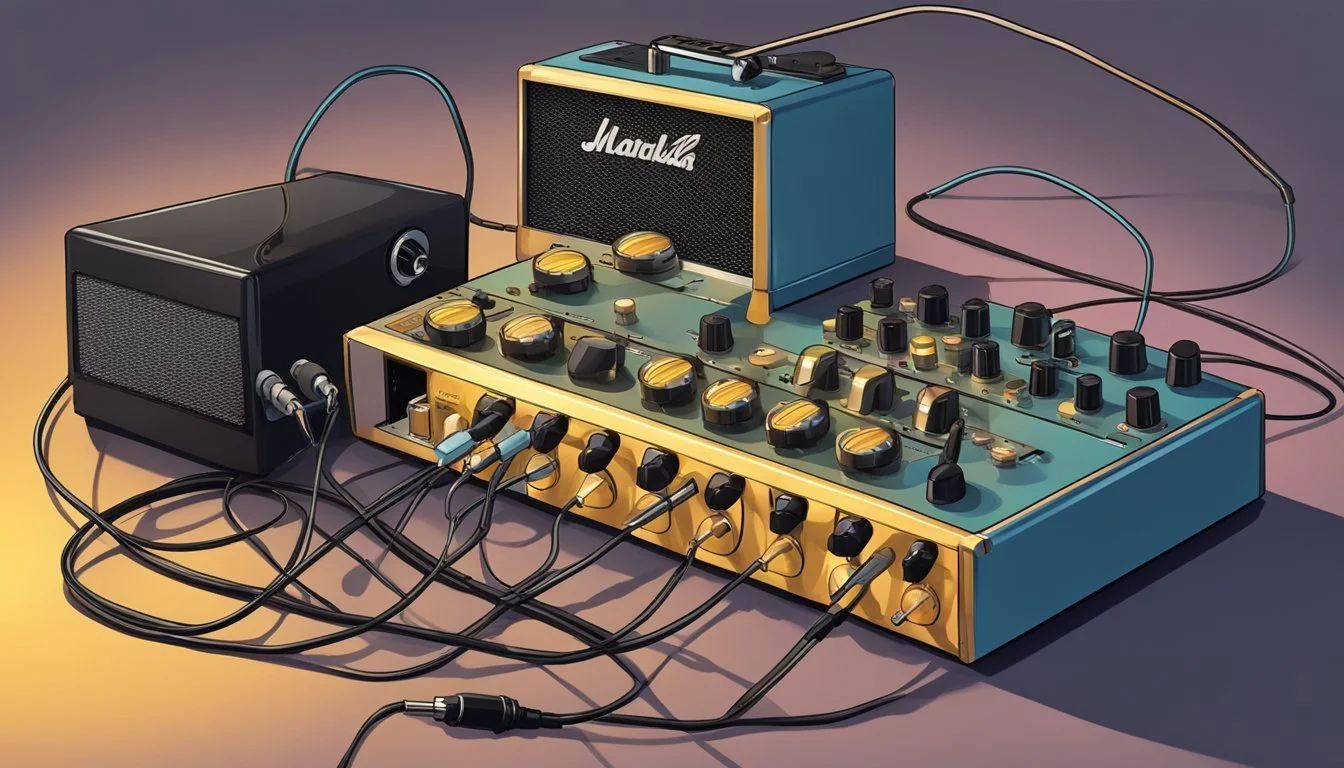Exploring the Fulltone OCD Guitar Effects Pedal
The Fulltone OCD (Obsessive Compulsive Drive) has become a staple on pedalboards worldwide since its introduction in 2004. This overdrive pedal offers guitarists a unique blend of tube-like warmth and transparent gain that enhances their tone without overpowering it. The OCD's versatility allows it to function as both a subtle boost and a high-gain powerhouse, making it suitable for a wide range of musical genres and playing styles.
Designed by Mike Fuller, the OCD has undergone several iterations over the years, each refining its core sound while maintaining the qualities that made it popular. The pedal features simple controls - Volume, Drive, and Tone - along with a HP/LP switch that alters the frequency response. This straightforward layout belies the pedal's tonal complexity, which has made it a favorite among amateur and professional guitarists alike.
The Fulltone OCD's ability to respond dynamically to playing technique sets it apart from many other overdrive pedals. It cleans up well when guitar volume is rolled back and can push tube amplifiers into natural-sounding saturation. These characteristics have contributed to its reputation as one of the most versatile and responsive overdrive pedals on the market.
History of OCD Overdrive
The OCD (Obsessive Compulsive Drive) overdrive pedal has become a staple in many guitarists' pedalboards since its introduction. This innovative device has undergone several iterations, cementing its place in the world of guitar effects.
Development by Mike Fuller
Mike Fuller, the founder of Fulltone, created the OCD overdrive pedal in 2004. Fuller's goal was to design an overdrive that could produce tube-like tones in a compact, affordable package. He spent months refining the circuit, testing various components to achieve the desired sound.
The OCD's unique circuit incorporated both MOSFET and op-amp technologies. This combination allowed the pedal to generate a wide range of overdrive tones, from subtle breakup to high-gain distortion.
Fuller's attention to detail extended to the pedal's construction. He insisted on using high-quality components and true bypass switching to maintain signal integrity.
OCD Pedal Evolution
Since its initial release, the Fulltone OCD has undergone several revisions. Each version aimed to improve upon its predecessor while maintaining the core sound that made the pedal famous.
Version 1.0 established the OCD's reputation for versatility and dynamic response. Version 1.1 introduced minor circuit tweaks to enhance tonal clarity.
Version 1.2 saw a significant change with the addition of a hi-cut/lo-cut switch. This feature allowed players to tailor the pedal's frequency response to their setup.
Version 1.3 and 1.4 further refined the circuit, improving note definition and reducing noise. The latest version, 2.0, introduced enhanced headroom and a more pronounced midrange.
The OCD's success has inspired numerous clones and similar designs from other manufacturers. These pedals often aim to capture the OCD's coveted tone while adding their own unique features.
Technical Specifications
The Fulltone OCD overdrive pedal boasts impressive technical specifications that contribute to its stellar performance and versatility. Key features include high input impedance, output buffering options, and innovative bypass configurations.
Input Impedance and Output Buffer
The Fulltone OCD features a high input impedance of 1 megaohm. This high impedance helps preserve the guitar's tone and dynamics, ensuring minimal signal loss when the pedal is engaged.
The output buffer is designed to maintain signal integrity, especially when using long cable runs or multiple pedals. This buffer helps prevent high-frequency loss and maintains the pedal's tonal characteristics.
Internal Switch and HP/LP Options
An internal switch allows users to adjust the pedal's bass response. This feature helps tailor the OCD's sound to different amplifiers and playing styles.
The HP/LP (High Peak/Low Peak) toggle switch on the OCD V2 offers two distinct voicings. HP mode provides a brighter, more aggressive tone with enhanced pick attack. LP mode delivers a smoother, more compressed sound with increased sustain.
True Bypass and Enhanced Bypass Features
The Fulltone OCD V2 incorporates true bypass switching, ensuring a completely uncolored signal when the pedal is disengaged. This feature maintains tonal purity in complex pedalboard setups.
Enhanced bypass options include a Class A configured discrete 2N5457 JFET input section, which can be activated even when the pedal is off. This feature provides additional tonal shaping possibilities and improved interaction with other pedals in the signal chain.
Design and Build Quality
The Fulltone OCD overdrive pedal is renowned for its exceptional construction and component quality. These features contribute to its durability and reliability, making it a favorite among guitarists.
Pedal Construction
The Fulltone OCD boasts a rugged cast aluminum enclosure. This sturdy housing protects the internal components from damage, even under heavy use. The pedal's compact size allows for easy integration into pedalboards of all sizes.
True bypass switching ensures signal integrity when the pedal is disengaged. This feature preserves the guitar's tone when the effect is not in use.
The control knobs are securely mounted and provide smooth, precise adjustments. Their positioning allows for easy access during performances.
Component Selection
Fulltone uses high-quality components in the OCD's circuitry. This attention to detail enhances the pedal's performance and longevity.
The internal circuit board features carefully selected resistors, capacitors, and transistors. These components are chosen for their sonic characteristics and reliability.
A 9V battery compartment is easily accessible for quick changes. The pedal also accepts standard 9V DC power supplies, offering flexible powering options.
The input and output jacks are sturdy and well-soldered, ensuring consistent connections. This robust construction minimizes the risk of loose connections or signal loss over time.
Sound and Performance
The Fulltone OCD overdrive pedal offers versatile tonal shaping and responsive dynamics. Its sound quality and performance capabilities make it a popular choice among guitarists across genres.
Gain Settings and Tonal Range
The OCD provides a wide gain range, from subtle breakup to high-gain saturation. At lower gain settings, it adds warmth and slight compression to clean tones. As gain increases, the pedal produces classic rock tones with rich harmonics.
Higher gain settings deliver thick, saturated distortion suitable for heavy riffs and solos. The OCD retains note definition even at extreme gain levels.
The tone control allows fine-tuning of the pedal's EQ response. Rolling it back softens highs for smoother leads, while boosting adds bite and clarity.
Dynamic Response and EQ Settings
The OCD's dynamic response closely mimics tube amp behavior. It cleans up well when rolling back guitar volume, allowing players to control their tone from the instrument.
Its HP/LP switch toggles between two distinct EQ voicings. The HP (high peak) setting boosts upper midrange frequencies, ideal for cutting through dense mixes. LP (low peak) offers a warmer, more vintage-inspired tone.
The pedal's output buffer preserves signal integrity, minimizing tone loss in complex pedalboard setups. This feature helps maintain the guitar's natural character through long cable runs.
Comparison with Distortion Pedals
While many distortion pedals offer a more aggressive, compressed sound, the OCD maintains a more open, amp-like quality. It preserves pick attack and string dynamics better than typical distortion units.
The OCD's overdrive is less fizzy in the high end compared to many distortion pedals. This results in a more natural-sounding sustain and decay.
Unlike some distortion pedals that can sound artificial, the OCD blends well with an amp's natural overdrive. This makes it effective for boosting an already driven amp or as a standalone overdrive source.
Usage Scenarios
The Fulltone OCD overdrive pedal offers versatility across multiple musical genres. Its dynamic response and tonal range make it suitable for blues, rock, metal, and country styles, as well as providing transparent clean boosts.
Employing OCD in Blues Music
In blues contexts, the OCD excels at producing warm, tube-like overdrive. Players can set the drive control low for subtle grit or crank it up for searing lead tones. The pedal's responsive nature allows it to clean up when guitar volume is rolled back.
The HP/LP switch proves useful here. LP mode delivers a smoother, more vintage-style overdrive ideal for soulful blues licks. HP mode adds more bite and high-end clarity, cutting through dense mixes.
For Texas-style blues, players often pair the OCD with a Tube Screamer, using the OCD as a "always on" base tone and the Tube Screamer for solos.
Rock and Metal Applications
The OCD shines in rock and metal genres due to its ability to tighten up amp distortion. Many players use it as a boost in front of an already overdriven amp to add compression and sustain.
In high-gain settings, the pedal's mid-range focus helps lead parts cut through dense mixes. The tone control allows fine-tuning to match different amplifiers and pickups.
For classic rock tones, earlier OCD versions (V1 or V2) are often preferred. These offer a rawer, more aggressive character. Modern rock and metal players may lean towards newer versions for their increased headroom and tighter low-end.
Country Music and Clean Boosts
In country music, the OCD serves as an excellent transparent clean boost. Set with low drive and high volume, it pushes tube amps into sweet, subtle breakup without coloring the fundamental tone.
The pedal's HP mode is particularly useful here, adding sparkle to chicken pickin' licks. It enhances the snap and twang characteristic of Telecasters and other single-coil equipped guitars.
For pedal steel players, the OCD provides a touch of grit and sustain without muddying complex chord voicings. Its responsive nature preserves note definition in arpeggiated passages.
The OCD's ability to function as a transparent boost makes it valuable for lifting solos above rhythm parts in any genre, from country to jazz fusion.
Gear Integration
The OCD overdrive pedal offers versatile integration options for various guitar rigs. Its adaptability allows seamless incorporation into pedalboards, flexible positioning in signal chains, and dynamic interaction with tube amplifiers.
Integrating with Pedalboards
The compact size of the OCD overdrive makes it an excellent fit for most pedalboards. Its standard 9V DC power requirement allows easy connection to common power supplies. The pedal's durable metal housing withstands the rigors of frequent transport and stage use.
For optimal performance, place a buffer pedal before the OCD if using long cable runs. This preserves high-end frequencies and maintains signal integrity. Consider using low-profile patch cables to maximize space efficiency on crowded boards.
The OCD's true bypass switching prevents tone coloration when disengaged, making it compatible with other effects without unwanted interference.
Signal Chain Positioning
The OCD's versatility allows for effective placement at various points in the signal chain. Positioning it early, right after the guitar, provides a foundation for shaping the overall tone.
Placing the OCD after modulation effects like chorus or phaser can add grit and character to those sounds. For a cleaner boost, position it near the end of the chain, just before any delay or reverb pedals.
Experiment with stacking the OCD alongside other overdrive or distortion pedals. Place lower-gain pedals before the OCD for subtle layering, or position higher-gain pedals after it for more aggressive tones.
Interacting with Tube Amps
The OCD excels at pushing tube amps into natural overdrive. Set the amp's clean channel just on the edge of breakup for optimal interaction. The pedal's HP/LP switch allows fine-tuning of the frequency response to match different amp characteristics.
For cleaner tones, use the OCD as a boost by setting its Drive control low and Volume high. This pushes the amp's preamp tubes harder, creating natural compression and harmonic richness.
With high-headroom amps, the OCD can serve as the primary distortion source. Adjust the amp's EQ to complement the pedal's tone-shaping capabilities. The OCD's dynamic response preserves picking nuances and responds well to guitar volume changes.
Playing Techniques
The OCD overdrive pedal offers versatile tonal options that can be enhanced through specific playing techniques. Guitarists can leverage the pedal's responsive nature to achieve powerful sustain and shape their sound using volume controls.
Sustain and Power Chords
The OCD excels at producing rich, sustained tones. Players can maximize sustain by utilizing power chords and allowing notes to ring out. Experiment with different pickup selections to find the sweet spot for extended sustain.
Single-note lines also benefit from the OCD's sustain characteristics. Try holding notes slightly longer than usual to let the overdrive color shine through.
For power chords, use the pedal's drive control to dial in the desired amount of grit. Lower drive settings work well for rhythmic chugging, while higher settings create a more saturated sound for leads.
Volume Knob Interaction
The OCD responds dynamically to changes in guitar volume. Rolling back the volume knob cleans up the tone while maintaining clarity.
At full volume, the pedal delivers its signature overdrive. Reduce the guitar's volume gradually to explore a range of cleaner tones without adjusting the pedal.
This technique allows for seamless transitions between clean and overdriven sounds within a song. Practice quick volume adjustments to incorporate this dynamic control into your playing.
Try setting the OCD's drive higher and using your guitar's volume to control the amount of gain. This approach provides a wide tonal palette from a single pedal setting.
Market Considerations
The Fulltone OCD pedal holds a significant position in the guitar effects market. Its popularity and reputation influence both pricing and availability across new and used markets.
New vs. Used OCD Pedals
New Fulltone OCD pedals typically retail for $130-$150. Used OCDs can be found for $80-$120, depending on condition. Fair condition pedals may have cosmetic wear but function properly. Good condition OCDs show minimal signs of use. Excellent condition pedals appear nearly new.
Older OCD versions often command higher prices due to their sought-after tones. The used market offers opportunities to acquire discontinued models. However, newer versions provide updated features and potentially improved reliability.
Evaluating Cost Versus Performance
The Fulltone OCD delivers professional-grade overdrive at a relatively accessible price point. Its versatility suits various musical styles and guitar setups. The pedal's build quality contributes to its longevity, making it a sound investment for many players.
When comparing costs, consider:
Tonal preferences (vintage vs. modern voicings)
Desired features (e.g., buffer options in newer versions)
Long-term value retention
Trying multiple OCD versions can help determine which offers the best performance for individual needs and budget. The pedal's enduring popularity helps maintain its resale value.
The Serious Guitarist's Toolkit
A well-curated collection of effects pedals is essential for the dedicated guitarist. Quality gear enables tonal versatility and creative expression. Careful selection of pedals can elevate a player's sound and expand their musical possibilities.
Choosing the Right Effects
The serious guitarist's pedalboard often includes an overdrive pedal like the Fulltone OCD. This versatile effect adds depth and harmonic content to the guitar signal. A compression pedal is another key tool, helping to even out dynamics and increase sustain.
Modulation effects such as chorus, flanger, and phaser can add movement and texture to guitar tones. Time-based effects like delay and reverb are crucial for creating space and atmosphere in a guitarist's sound.
When selecting pedals, it's important to consider:
Sound quality
Versatility
Build quality
Signal path placement
Many professional guitarists use a combination of "always-on" pedals and situational effects. This approach allows for a consistent base tone with the flexibility to add color when needed.
Testing pedals in person is ideal. This allows guitarists to evaluate how each effect interacts with their specific guitar and amplifier combination.
Future of Overdrive
Overdrive technology continues to evolve, with new innovations enhancing guitar tone and expanding sonic possibilities. Dynamic range and sensitivity remain key areas of focus for pedal designers.
Innovations in Overdrive Technology
Digital modeling is revolutionizing overdrive pedals. Advanced algorithms now replicate analog circuits with unprecedented accuracy, offering guitarists a wide palette of classic and modern tones in a single unit.
Hybrid analog-digital designs are gaining traction. These pedals combine the warmth of analog circuitry with the precision and flexibility of digital control, allowing for greater tonal shaping and recall capabilities.
Improved dynamic response is a priority for many manufacturers. New circuit designs aim to capture the nuanced interaction between player, instrument, and amplifier, resulting in more expressive and touch-sensitive overdrive effects.
Miniaturization is another trend, with pedal makers packing complex circuitry into increasingly compact enclosures. This allows guitarists to fit more tones onto their pedalboards without sacrificing floor space.





